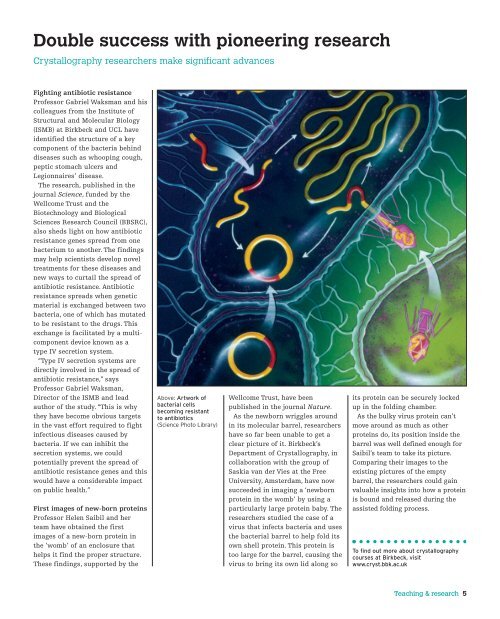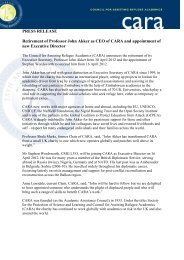over 2 copy - Birkbeck, University of London
over 2 copy - Birkbeck, University of London
over 2 copy - Birkbeck, University of London
You also want an ePaper? Increase the reach of your titles
YUMPU automatically turns print PDFs into web optimized ePapers that Google loves.
Double success with pioneering research<br />
Crystallography researchers make significant advances<br />
Fighting antibiotic resistance<br />
Pr<strong>of</strong>essor Gabriel Waksman and his<br />
colleagues from the Institute <strong>of</strong><br />
Structural and Molecular Biology<br />
(ISMB) at <strong>Birkbeck</strong> and UCL have<br />
identified the structure <strong>of</strong> a key<br />
component <strong>of</strong> the bacteria behind<br />
diseases such as whooping cough,<br />
peptic stomach ulcers and<br />
Legionnaires’ disease.<br />
The research, published in the<br />
journal Science, funded by the<br />
Wellcome Trust and the<br />
Biotechnology and Biological<br />
Sciences Research Council (BBSRC),<br />
also sheds light on how antibiotic<br />
resistance genes spread from one<br />
bacterium to another. The findings<br />
may help scientists develop novel<br />
treatments for these diseases and<br />
new ways to curtail the spread <strong>of</strong><br />
antibiotic resistance. Antibiotic<br />
resistance spreads when genetic<br />
material is exchanged between two<br />
bacteria, one <strong>of</strong> which has mutated<br />
to be resistant to the drugs. This<br />
exchange is facilitated by a multicomponent<br />
device known as a<br />
type IV secretion system.<br />
“Type IV secretion systems are<br />
directly involved in the spread <strong>of</strong><br />
antibiotic resistance,” says<br />
Pr<strong>of</strong>essor Gabriel Waksman,<br />
Director <strong>of</strong> the ISMB and lead<br />
author <strong>of</strong> the study. “This is why<br />
they have become obvious targets<br />
in the vast effort required to fight<br />
infectious diseases caused by<br />
bacteria. If we can inhibit the<br />
secretion systems, we could<br />
potentially prevent the spread <strong>of</strong><br />
antibiotic resistance genes and this<br />
would have a considerable impact<br />
on public health.”<br />
First images <strong>of</strong> new-born proteins<br />
Pr<strong>of</strong>essor Helen Saibil and her<br />
team have obtained the first<br />
images <strong>of</strong> a new-born protein in<br />
the ’womb’ <strong>of</strong> an enclosure that<br />
helps it find the proper structure.<br />
These findings, supported by the<br />
Above: Artwork <strong>of</strong><br />
bacterial cells<br />
becoming resistant<br />
to antibiotics<br />
(Science Photo Library)<br />
Wellcome Trust, have been<br />
published in the journal Nature.<br />
As the newborn wriggles around<br />
in its molecular barrel, researchers<br />
have so far been unable to get a<br />
clear picture <strong>of</strong> it. <strong>Birkbeck</strong>’s<br />
Department <strong>of</strong> Crystallography, in<br />
collaboration with the group <strong>of</strong><br />
Saskia van der Vies at the Free<br />
<strong>University</strong>, Amsterdam, have now<br />
succeeded in imaging a ‘newborn<br />
protein in the womb’ by using a<br />
particularly large protein baby. The<br />
researchers studied the case <strong>of</strong> a<br />
virus that infects bacteria and uses<br />
the bacterial barrel to help fold its<br />
own shell protein. This protein is<br />
too large for the barrel, causing the<br />
virus to bring its own lid along so<br />
its protein can be securely locked<br />
up in the folding chamber.<br />
As the bulky virus protein can’t<br />
move around as much as other<br />
proteins do, its position inside the<br />
barrel was well defined enough for<br />
Saibil’s team to take its picture.<br />
Comparing their images to the<br />
existing pictures <strong>of</strong> the empty<br />
barrel, the researchers could gain<br />
valuable insights into how a protein<br />
is bound and released during the<br />
assisted folding process.<br />
To find out more about crystallography<br />
courses at <strong>Birkbeck</strong>, visit<br />
www.cryst.bbk.ac.uk<br />
Teaching & research 5



